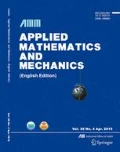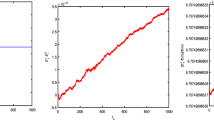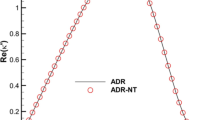Abstract
Two improved isogeometric quadratic elements and the central difference scheme are used to formulate the solution procedures of transient wave propagation problems. In the proposed procedures, the lumped matrices corresponding to the isogeometric elements are obtained. The stability conditions of the solution procedures are also acquired. The dispersion analysis is conducted to obtain the optimal Courant-Friedrichs-Lewy (CFL) number or time-step sizes corresponding to the spatial isogeometric elements. The dispersion analysis shows that the isogeometric quadratic element of the fourth-order dispersion error (called the isogeometric analysis (IGA)-f quadratic element) provides far more desirable numerical dissipation/dispersion than the element of the second-order dispersion error (called the IGA-s quadratic element) when appropriate time-step sizes are selected. The numerical simulations of one-dimensional (1D) transient wave propagation problems demonstrate the effectiveness of the proposed solution procedures.
Similar content being viewed by others
References
Kampanis, N. A., Dougalis, V. A., and Ekaterinaris, J. A. Effective Computational Methods for Wave Propagation, Chapman & Hall/CRC, New York (2008)
Bathe, K. J. Finite Element Procedures, Prentice-Hall, New Jersey (2014)
Mullen, R. and Belytschko, T. Dispersion analysis of finite element semidiscretizations of the two-dimensional wave equation. International Journal for Numerical Methods in Engineering, 18, 11–29 (2010)
Abboud, N. N. and Pinsky, P. M. Finite element dispersion analysis for the three-dimensional second-order scalar wave equation. International Journal for Numerical Methods in Engineering, 35, 1183–1218 (2010)
Thompson, L. L. and Pinsky, P. M. Complex wavenumber Fourier analysis of the p-version finite element method. Computational Mechanics, 13, 255–275 (1994)
Suleau, S., Deraemaeker, A., and Bouillard, P. Dispersion and pollution of meshless solutions for the Helmholtz equation. Computer Methods in Applied Mechanics & Engineering, 190, 639–657 (2000)
Noh, G. and Ham, S. Performance of an implicit time integration scheme in the analysis of wave propagations. Computers & Structures, 123, 93–105 (2013)
Kolman, R., Okrouhlík, M., Berezovski, A., Gabriel, D., Kopačka, J., and Plešek, J. B-spline based finite element method in one-dimensional discontinuous elastic wave propagation. Applied Mathematical Modelling, 46, 382–395 (2017)
Komijani, M. and Gracie, R. An enriched finite element model for wave propagation in fractured media. Finite Elements in Analysis and Design, 125, 14–23 (2017)
Petersen, S., Dreyer, D., and von Estorff, O. Assessment of finite and spectral element shape functions for efficient iterative simulations of interior acoustics. Computer Methods in Applied Mechanics and Engineering, 195, 6463–6478 (2006)
Komatitsch, D. and Vilotte, J. P. The Spectral Element method: an efficient tool to simulate the seismic response of 2D and 3D geological structures. Bulletin of the Seismological Society of America, 88, 368–392 (1998)
Pasquetti, R. and Rapetti, F. Spectral element methods on triangles and quadrilaterals: comparisons and applications. Journal of Computational Physics, 198, 349–362 (2004)
Seriani, G. and Priolo, E. Spectral element method for acoustic wave simulation in heterogeneous media. Finite Elements in Analysis and Design, 16, 337–348 (1994)
Żak, A. A novel formulation of a spectral plate element for wave propagation in isotropic structures. Finite Elements in Analysis and Design, 45, 650–658 (2009)
Herreros, M. I. and Mabssout, M. A two-steps time discretization scheme using the SPH method for shock wave propagation. Computer Methods in Applied Mechanics and Engineering, 200, 1833–1845 (2011)
Jia, X. and Hu, T. Element-free precise integration method and its applications in seismic modelling and imaging. Geophysical Journal of the Royal Astronomical Society, 166, 349–372 (2006)
Godinho, L., Dors, C., Soares, D., Jr., and Amado-Mendes, P. Solution of time-domain acoustic wave propagation problems using a RBF interpolation model with “a priori” estimation of the free parameter. Wave Motion, 48, 423–440 (2011)
Soares, D. J. A time-domain FEM-BEM iterative coupling algorithm to numerically model the propagation of electromagnetic waves. Computer Modeling in Engineering & Sciences, 32, 57–68 (2008)
Nicomedes, W. L., Mesquita, R. C., and Moreira, F. J. S. Meshless local Petrov-Galerkin (MLPG) methods in quantum mechanics. Compel International Journal for Computation & Mathematics in Electrical & Electronic Engineering, 30, 1763–1776 (2013)
Kim, K. T. and Bathe, K. J. Transient implicit wave propagation dynamics with the method of finite spheres. Computers & Structures, 173, 50–60 (2016)
Ham, S., Lai, B., and Bathe, K. J. The method of finite spheres for wave propagation problems. Computers & Structures, 142, 1–14 (2014)
Ded`e, L., Jäggli, C., and Quarteroni, A. Isogeometric numerical dispersion analysis for twodimensional elastic wave propagation. Computer Methods in Applied Mechanics and Engineering, 284, 320–348 (2015)
Wang, D., Liang, Q., and Zhang, H. A superconvergent isogeometric formulation for eigenvalue computation of three dimensional wave equation. Computational Mechanics, 57, 1037–1060 (2016)
Idesman, A., Pham, D., Foley, J. R., and Schmidt, M. Accurate solutions of wave propagation problems under impact loading by the standard, spectral and isogeometric high-order finite elements: comparative study of accuracy of different space-discretization techniques. Finite Elements in Analysis and Design, 88, 67–89 (2014)
Wang, D., Liu, W., and Zhang, H. Novel higher order mass matrices for isogeometric structural vibration analysis. Computer Methods in Applied Mechanics and Engineering, 260, 92–108 (2013)
Wang, D., Liu, W., and Zhang, H. Superconvergent isogeometric free vibration analysis of Euler–Bernoulli beams and Kirchhoff plates with new higher order mass matrices. Computer Methods in Applied Mechanics and Engineering, 286, 230–267 (2015)
Cohen, G., Joly, P., and Tordjman, N. Higher-order finite elements with mass-lumping for the 1D wave equation. Finite Elements in Analysis and Design, 16, 329–336 (1994)
Hughes, T. J. R., Reali, A., and Sangalli, G. Duality and unified analysis of discrete approximations in structural dynamics and wave propagation: comparison of p-method finite elements with k-method NURBS. Computer Methods in Applied Mechanics and Engineering, 197, 4104–4124 (2008)
Cottrell, J. A., Reali, A., Bazilevs, Y., and Hughes, T. J. R. Isogeometric analysis of structural vibrations. Computer Methods in Applied Mechanics and Engineering, 195, 5257–5296 (2006)
Benson, D. J., Bazilevs, Y., de Luycker, E., Hsu, M. C., Scott, M., Hughes, T. J. R., and Belytschko, T. A generalized finite element formulation for arbitrary basis functions: from isogeometric analysis to XFEM. International Journal for Numerical Methods in Engineering, 83, 765–785 (2010)
Idesman, A. Accurate time integration of linear elastodynamics problems. CMES-Computer Modeling in Engineering and Sciences, 71, 111–148 (2011)
Idesman, A. V. and Mates, S. P. Accurate finite element simulation and experimental study of elastic wave propagation in a long cylinder under impact loading. International Journal of Impact Engineering, 71, 1–16 (2014)
Idesman, A. Optimal reduction of numerical dispersion for wave propagation problems, part 1: application to 1-D isogeometric elements. Computer Methods in Applied Mechanics & Engineering, 317, 970–992 (2017)
Idesman, A. and Dey, B. Optimal reduction of numerical dispersion for wave propagation problems, part 2: application to 2-D isogeometric elements. Computer Methods in Applied Mechanics and Engineering, 321, 235–268 (2017)
Jiang, L. and Rogers, R. J. Effects of spatial discretization on dispersion and spurious oscillations in elastic wave propagation. International Journal for Numerical Methods in Engineering, 29, 1205–1218 (1990)
Yue, B. and Guddati, M. N. Dispersion-reducing finite elements for transient acoustics. Journal of the Acoustical Society of America, 20, 2132–2141 (2005)
Chien, C. C., Yang, C. S., and Tang, J. H. Three-dimensional transient elastodynamic analysis by a space and time-discontinuous Galerkin finite element method. Finite Elements in Analysis and Design, 39, 561–580 (2003)
Chung, J. and Lee, J. M. A new family of explicit time integration methods for linear and non-linear structural dynamics. International Journal for Numerical Methods in Engineering, 37, 3961–3976 (1994)
Subbaraj, K. and Dokainish, M. A. A survey of direct time-integration methods in computational structural dynamics, I: explicit methods. Computers & Structures, 32, 1371–1386 (1989)
Subbaraj, K. and Dokainish, M. A. A survey of direct time-integration methods in computational structural dynamics, II: implicit methods. Computers & Structures, 32, 1387–1401 (1989)
Noh, G. and Bathe, K. J. An explicit time integration scheme for the analysis of wave propagations. Computers & Structures, 129, 178–193 (2013)
Wen, W. B., Duan, S. Y., Yan, J., Ma, Y. B., Wei, K., and Fang, D. N. A quartic B-spline based explicit time integration scheme for structural dynamics with controllable numerical dissipation. Computational Mechanics, 59, 403–418 (2017)
Author information
Authors and Affiliations
Corresponding author
Additional information
Project supported by the National Natural Science Foundation of China (Nos. 11602004 and 11325210)
Rights and permissions
About this article
Cite this article
Wen, W., Luo, S., Duan, S. et al. Improved quadratic isogeometric element simulation of one-dimensional elastic wave propagation with central difference method. Appl. Math. Mech.-Engl. Ed. 39, 703–716 (2018). https://doi.org/10.1007/s10483-018-2330-6
Received:
Revised:
Published:
Issue Date:
DOI: https://doi.org/10.1007/s10483-018-2330-6




